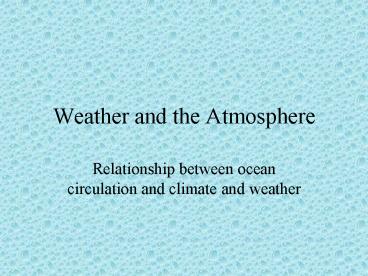Weather and the Atmosphere PowerPoint PPT Presentation
1 / 21
Title: Weather and the Atmosphere
1
Weather and the Atmosphere
- Relationship between ocean circulation and
climate and weather
2
I. How ocean water moves
- A. tidal currents
- - movement based on relationship of Earth and
moon - - do not effect global water movement very much
3
How ocean water moves
- B. wind driven circulation
- - Top layer of the ocean is affected only
- - Driven by Trade and Westerlies
- Wind exerts force on the
- oceans surface and produces waves
4
(No Transcript)
5
How ocean water moves
- C. thermohaline circulation
- Ocean is a big conveyor belt
- - due to changes in temperature and salinity
- caused by exchange of heat and freshwater between
the ocean and atmosphere - - cooling and evaporation make ocean water more
dense (saltier) thus causing it to sink, which in
turn forces less dense and warmer water to rise
up toward the surface
6
(No Transcript)
7
II. Earth is one large system
8
Everything is connected
- A. Ocean is part of the earth system which
also includes - 1. atmosphere
- 2. land
- life
- B. A change in any part of the earth system will
cause changes through out the total system
9
III. The ocean drives the atmospheric
circulation by heating the atmosphere, mostly in
the tropics
- A. most of the sunlight absorbed by earth is
absorbed at the top of the tropical ocean
(atmosphere is too transparent to absorb much
sunlight)
10
The ocean drives the atmospheric circulation by
heating the atmosphere, mostly in the tropics
- B. ocean loses heat by evaporation ( latent heat
release) Trade winds carry evaporated to areas
where it condenses as rain Condensation releases
latent heat and warms the air warm air rises,
further drawing in warm, wet air, releasing more
heat
11
The ocean drives the atmospheric circulation by
heating the atmosphere, mostly in the tropics
- C. winds drive ocean currents and together they
carry heat from the tropics to the polar regions
12
The ocean drives the atmospheric circulation by
heating the atmosphere, mostly in the tropics
- D. Oceans control the amount of carbon
dioxide in the atmosphere - 1. - most of the available carbon is in the
oceans - 2. - almost half of the carbon dioxide put
into the air by burning fossil fuels is absorbed
by the ocean - - carbon dioxide dissolves in cold water, cold
water sinks, so the carbon dioxide is carried
away from the atmosphere carbon dioxide is later
released back into the atmosphere as the ocean
water mixes and moves
13
Carbon Dioxide and Temperature
14
Carbon Dioxide and Temperature
15
IV. Phytoplankton strongly influence cloud
formation
- Clouds influence the reflection of sunlight from
the earth, which influences earths temperature.
16
Phytoplankton under a microscope
17
Phytoplankton strongly influence cloud formation
- B. Phytoplankton release great amounts of
sulfurous gas (dimethyl sulfide) which changes
the way clouds are formed in the atmosphere.
(sunlight causes chemical reactions that change
the gas to sulfate aerosols the tiny aerosol
particles cause water vapor to condense to form
cloud droplets)
18
(No Transcript)
19
Phytoplankton strongly influence cloud formation
- C. 1/3 of sunlight reaching the earth is
reflected back to space, so any process that
influences cloudiness also influences the amount
of sunlight absorbed by earth
20
Ocean Influences On Regional Climate
- A. Differences in temperature between the land
and the ocean drives monsoons
21
Ocean Influences On Regional Climate
- B. Cities along coasts benefit from sea breezes

